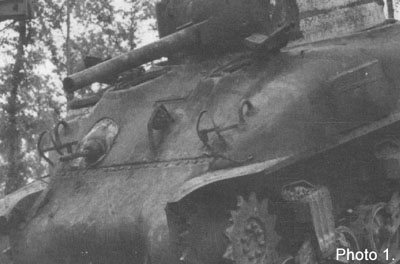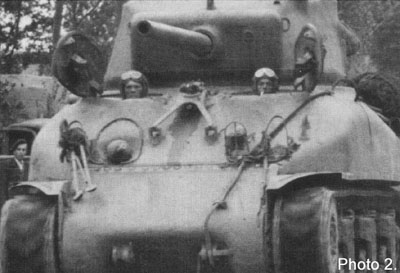The ESCI Sherman Debacle
It was a cold day in February, when my
world was turned upside down. Until that day, I had thought that
ESCI kits were infallable. Perfect. The epitome of the model
maker's craft. But then, with a single email, all that changed.
The day started normal. Wake up, shower,
turn on my computer, and while it's booting up, get some
breakfast. I logged on to the web, checked my email, and lo and
behold, there was a note from my good friend, Jim Matthiessen.
Nothing unusual there. We correspond quite often, and I always
look forward to his notes.
But this time it was to be different. I
read the subject header in all innocence, not yet aware that my
whole world was about to change forever. It said something fairly
innocuous, but hinting a much deeper problem: "Question
About ESCI's Sherman Kits."
"Hmmm. I wonder what's up?" I
thought. I opened the message, and there, in the simple Arial 12
pt. font, were the words that sent a chill down my spine: "I
think that ESCI screwed up their Sherman kits by having the wrong
type of hull."
But even then, I still tried to ignore the
chill. "What sort of gibberish is he talking about
now?" I thought. I read on.
 According to Jim, who is much more knowledgeable
about Shermans than I, there were several basic styles of front
hull for the M4A1 Sherman, two of which concern us. First, there
was an early version that had a 56 degree angle to it, and the
hatches were parallel to the side of the vehicle. There are
pronounced bulges in front of the hatches (see Photo 1). Second,
we have the late version hull, which appeared at the time they
incorporated wet stowage for the cannon ammunition. This hull had
a 47 degree angle to the front plate, and the hatches opened on
an angle (see Photo 2). This is the style of hull that is
included in the ESCI M4A1 kit. Jim's question was, "Is this
hull style correct for a 75mm Sherman?"
According to Jim, who is much more knowledgeable
about Shermans than I, there were several basic styles of front
hull for the M4A1 Sherman, two of which concern us. First, there
was an early version that had a 56 degree angle to it, and the
hatches were parallel to the side of the vehicle. There are
pronounced bulges in front of the hatches (see Photo 1). Second,
we have the late version hull, which appeared at the time they
incorporated wet stowage for the cannon ammunition. This hull had
a 47 degree angle to the front plate, and the hatches opened on
an angle (see Photo 2). This is the style of hull that is
included in the ESCI M4A1 kit. Jim's question was, "Is this
hull style correct for a 75mm Sherman?"
 He wanted my help in researching this issue, because
he knew that I am a proud owner of the marvelous Hunnicutt book
on the Sherman tank. So I figured I'd humor him. "Yeah
right. Like ESCI would make a mistake like THAT."
Considering the extremely high quality of the ESCI Sherman kit, I
found it more likely that Jim was seeing errors where there were
none; probably trying to impress me with his vast knowledge of
the Sherman tank.
He wanted my help in researching this issue, because
he knew that I am a proud owner of the marvelous Hunnicutt book
on the Sherman tank. So I figured I'd humor him. "Yeah
right. Like ESCI would make a mistake like THAT."
Considering the extremely high quality of the ESCI Sherman kit, I
found it more likely that Jim was seeing errors where there were
none; probably trying to impress me with his vast knowledge of
the Sherman tank.
So that night I took out the Hunnicutt
book, as well as the "Sherman in Action" book by
Squadron. I started reading slowly, just casually flipping
through the pages, looking at the photos, but then a creepy
feeling came over me as I started to see hints at what Jim had
been talking about. I read deeper. I didn't want to, but it was
like a car accident on the side of the road; I just couldn't pull
my eyes away.
I pulled out another Sherman book, this one
by Concord. And another Concord book on the tank battles at
Normandy. Anything I could find with Sherman photos. Everything
pointed to the awful truth that Jim was right.
And now, after several months of looking at
every Sherman photo, and reading every reference that I can find,
I am forced to admit that Jim is absolutely correct. ESCI screwed
up. And now I have to live with the hard truth that ESCI is not
the god of 1/72nd armor modeling that I once thought it was. It's
taking time, but I'm gradually coming to terms with it.
So, for the viewer's edification, I shall
now relate the problem with the ESCI M4A1 Sherman kit:
The late-style, 47 degree, wet-stowage,
M4A1 hull was never paired with the 75mm turret.
According to all my research (which I admit
is limited to readily available literature on the subject, and
not any primary research on my part), this late style hull made
its appearance with the 76mm turret, as correctly represented by
the Revell/Matchbox/Monogram kit. I imagine that at some point
there may have been a field-repaired Sherman that was cobbled
together from parts of several vehicles, and may have had the
unusual combination of the wet-stowage hull with a 75mm turret,
but I have never seen a picture of one.
So there you have it. One of ESCI's finest
kits (considering level of detail, and quality of engineering) is
of a vehicle that simply never existed. I am bummed.
Wanted: If anybody reading this has any information on M4A1
75mm Shermans with the late style, wet-stowage hull, I would LOVE
to hear about it.
Post-script: I have seen a discussion on the
track-link.reference newsgroup, which discusses this question.
There were apparently a handful of U.S. DD (Duplex-Drive) tanks
at Normandy which used this combination. Seems that the 76mm gun
was too long to fit behind the DD apparatus. Note, that there
were few, if any, British DD tanks based on the M4A1. They were
primarily M4A2's, and M4A4's. I have heard many assertions that
various Commonwealth nations had used the this style of Sherman,
but have yet to see photographic evidence of this.
So... this vehicle apparently existed, but
in such insignificant numbers as to make this a very esoteric kit
indeed.
Update:
So, how do we fix this kit? I guess that
depends on what you want to make with it. There are several
options:
First, we can can pair the ESCI hull with a
76mm turret. You can get a turret fairly easily from Revell, but
there have been several poor reviews of the shape of the Revell
turret, so some work would be necessary to fix it. Otherwise,
there are resin turrets available, from Al.By, and possibly
others.
Or, we can add applique armor plates to the
sides of the ESCI hull, to make the hull an accurate, late style,
dry-stowage hull. Although this was not a very common vehicle, it
was much more common than the current kit. There is a book
available, called something like the "Modeler's Guide to the
Sherman Tank." It is focused mainly towards the 1/35th scale
modeler, but there is a bunch of useful drawings and information
for small scalers as well. It contains drawings of this hull,
with correct placement of the applique armor.
Finally, if you feel real adventurous, you
can scratchbuild an early style, dry-stowage hull, which would
take considerable re-working of the forward part of the hull, in
front of the hatches. In my opinion, this is the hull which should
have been included with the kit, considering how common it was.
 According to Jim, who is much more knowledgeable
about Shermans than I, there were several basic styles of front
hull for the M4A1 Sherman, two of which concern us. First, there
was an early version that had a 56 degree angle to it, and the
hatches were parallel to the side of the vehicle. There are
pronounced bulges in front of the hatches (see Photo 1). Second,
we have the late version hull, which appeared at the time they
incorporated wet stowage for the cannon ammunition. This hull had
a 47 degree angle to the front plate, and the hatches opened on
an angle (see Photo 2). This is the style of hull that is
included in the ESCI M4A1 kit. Jim's question was, "Is this
hull style correct for a 75mm Sherman?"
According to Jim, who is much more knowledgeable
about Shermans than I, there were several basic styles of front
hull for the M4A1 Sherman, two of which concern us. First, there
was an early version that had a 56 degree angle to it, and the
hatches were parallel to the side of the vehicle. There are
pronounced bulges in front of the hatches (see Photo 1). Second,
we have the late version hull, which appeared at the time they
incorporated wet stowage for the cannon ammunition. This hull had
a 47 degree angle to the front plate, and the hatches opened on
an angle (see Photo 2). This is the style of hull that is
included in the ESCI M4A1 kit. Jim's question was, "Is this
hull style correct for a 75mm Sherman?"  He wanted my help in researching this issue, because
he knew that I am a proud owner of the marvelous Hunnicutt book
on the Sherman tank. So I figured I'd humor him. "Yeah
right. Like ESCI would make a mistake like THAT."
Considering the extremely high quality of the ESCI Sherman kit, I
found it more likely that Jim was seeing errors where there were
none; probably trying to impress me with his vast knowledge of
the Sherman tank.
He wanted my help in researching this issue, because
he knew that I am a proud owner of the marvelous Hunnicutt book
on the Sherman tank. So I figured I'd humor him. "Yeah
right. Like ESCI would make a mistake like THAT."
Considering the extremely high quality of the ESCI Sherman kit, I
found it more likely that Jim was seeing errors where there were
none; probably trying to impress me with his vast knowledge of
the Sherman tank.